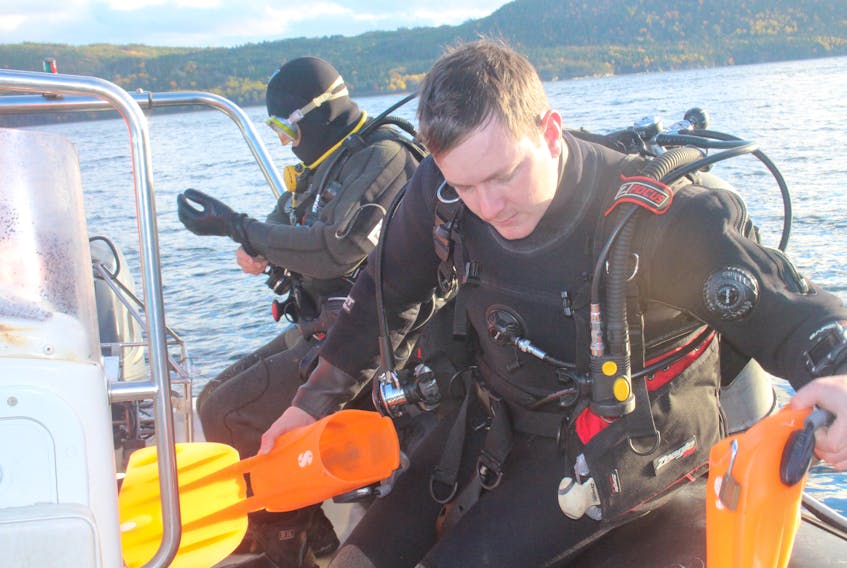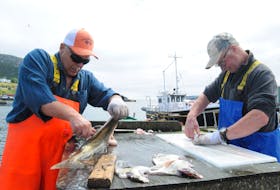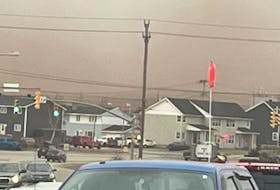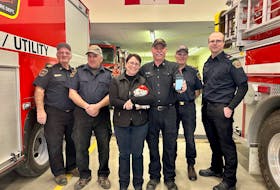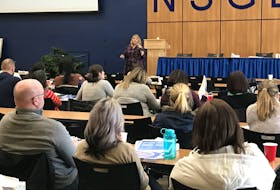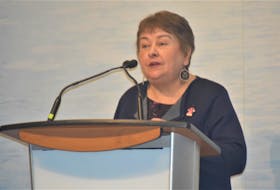BAIE VERTE, N.L.
With the wind having died out long enough to calm the waters Oct. 23, a research vessel rocks gently on the lops along the shallow waters of Baie Verte’s harbour.
Two scuba divers – Memorial University Newfoundland (MUN) associate professor Patrick Gagnon and student Logan Zeinert – are preparing to make their descent into the chilly waters below.
While the town has found prosperity mining its land resources, Gagnon believes there’s another potential fortune in the waters below: green sea urchins. The spiny creatures’ roe – spawn – can fetch more than $150 U.S. per kilogram. His aim is to develop a farm-based fishery, which can be on land, or potentially on the water through the use of crates.

Research
But this was no spur of the moment idea for Gagnon. He has been working on this project for the past three years since his Norway partners reached out about testing a feed developed to bulk up urchin roe for markets in Asia.
Gagnon carried out the research at MUN’s Ocean Sciences Centre and got positive results.
“After four weeks, it was enough to bring the roe to the standards we are looking for,” he said.
But the first round of testing produced a bitter tasting product and the colour wasn’t as vibrant as desired.
“After my partners improved the formula, it improved taste and colour significantly,” he said.
With a formula that works, although it still needs a little fine tuning, and after getting a trial farming project approved, Gagnon didn’t want to delay progress any further.
Potential
“We want to export our know-how to rural regions, because the idea is that it will hopefully lead to business start-ups,” he said. “Hopefully it can stimulate the economy for rural regions, which we know have seen a downturn over the years.”
Should an urchin production start, Gagnon stated, it could lead to land-based production facilities, which would need divers to retrieve the species, plant workers to grow urchins, and drivers for shipment to airports.
Related stories:
Thriving Regions workshop examines new ideas for Baie Verte Peninsula
N.L. sea urchin research draws attention
Taking stock
But the aim of the Oct. 23 trip was to quantify biomass to scout potential production sites.
“If you want to start a production, the first thing is you want to make sure you have access to urchin,” he said.
Two approaches were used for the mission, camera surveillance and scuba diving.
The camera provided some indication of what was happening on the bottom, however, Gagnon wanted a first-hand look. A quick spit polish of the googles to prevent fogging brings a quick joke between the divers about how classy the job can be, but it quickly becomes all business again. With their gear in place, the two raise their hands to their breathing apparatus and fall backwards into six-degree Celsius water.
They stay above water just long enough to adjust their equipment before dipping below the surface in search of urchins. Meanwhile MUN student Sean Hacker Teper moves the vessel out of harm’s way, watching the divers’ bubbles rise from the surface.
The bubbles are a good sign. It’s when he can’t see them the worry starts, as it could likely mean trouble for the divers. But after just seven minutes there’s a breach at the surface, and two sacks – with approximately 80 sea urchins – have been filled.
It was much better than Gagnon was expecting, as they had scouted the area earlier through video surveillance, had shown poor results. He surmises that on screen the urchins had camouflaged with the sea bed’s rocks.
After removing his gear, including some 60 pounds in weights, Gagnon is back on the vessel to inspect the bounty.
He takes out a knife, proceeds to cut through the spiny layer to reveal the roe, which is produced by both the male and the female.
A quick inspection reveals it’s a male, as it has a whiter, milkier texture, which isn’t as popular as female roe.
Overall, the first dive was a success and they plan to test four other sites along the Baie Verte Peninsula before making any final decisions on a location.

Enthusiasm
At the wharf, there’s local enthusiasm. Brothers Bern and Ron Barker were visiting with the research team. They had spoken earlier about possible locations.
Some 20 years back, Bern estimates, Baie Verte was harvesting and processing sea urchins.
“It was done on a basic level, but it was done here,” he said.
While he has long retired from the fishery, Bern was excited about the potential.
“There’s still a few inshore fishermen in the area, so if it’s profitable and a fishery can be made of it, let’s go for it,” he said.
- Tell us what you think!
- Write us a letter to the editor and email it to [email protected]. Be sure to include a name, address and daytime telephone number where the author can be contacted. Letters should be no more than 300 words.

